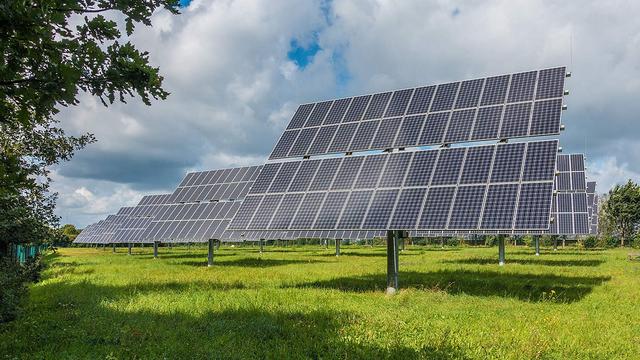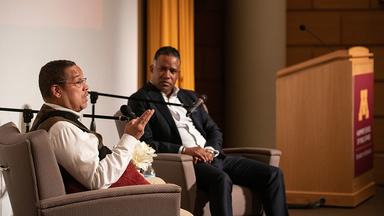When most people think of solar energy, they think of large solar panels installed on the rooftops of individual homes and businesses. Solar energy is seen as a key strategy to reduce the environmental impacts of energy use, and can also save money for consumers.
But it can be expensive to buy and difficult to access those traditional rooftop solar panels, so Humphrey School Assistant Professor Gabe Chan is exploring a more accessible option – community shared solar power.
Community solar systems, sometimes called solar gardens, are solar installations that benefit multiple community members and organizations by sharing ownership of a solar project, or by allowing subscriptions that pass along the benefits of solar generation to participating homes or organizations.
Community solar allows any energy consumer—from individual households, to community centers, to industrial customers—to work together to capture the benefits of solar without having to finance the solar project upfront themselves or to install any equipment on their individual homes, says Chan.
Chan, a faculty member in the School’s science, technology, and environmental policy area, studies the deployment and benefits of community solar in Minnesota and other states around the country.
“Community solar is an affordable way for people to take advantage of sustainable energy sources, and Minnesota is a leader in that regard,” says Chan. “It’s important to understand the diversity of approaches that other states are taking to expand access to community solar, especially for low- and moderate-income households.”
To that end, Chan and a team from the Humphrey School last week released the results of a two-year study on how to expand community solar availability in Texas, in collaboration with researchers at the LBJ School of Public Affairs at the University of Texas at Austin.
As one of the sunniest states, Texas has great potential for community solar, but Chan says its market is relatively small compared to the rest of the country.
The research team found that a key step toward improving access to community solar in Texas would be to involve community-based organizations such as churches, schools, and community development corporations to act as liaisons with developers, electric utilities, financers, and customers.
Matthew Grimley, a research fellow in Professor Chan’s lab, says the Humphrey School’s role in the research was to provide some national perspective: to present case studies from various cities and states that demonstrated what it takes to put the “community” in community solar.
“We interviewed dozens of diverse community-based organizations across the country. We learned that these groups are doing a lot more to organize communities and create meaningful, local benefits than people think. That’s incredibly important for seizing the full opportunities of community shared solar,” says Grimley.
“Community solar projects and programs vary tremendously across the country,” Chan says. “To be successful, community solar efforts need to be tailored to the specific circumstances of the communities they hope to benefit—and this is done best when communities and community-based organizations themselves play key roles in shaping projects.”
Community solar has proliferated around the country over the past five years. Last year, community solar was one of the fastest growing segments for solar and is expected to power as many as 650,000 homes nationally in the next five years. Chan says 20 states and the District of Columbia have passed legislation to require community solar programs.
However, Texas is unlikely to follow that model because it’s not a state with a history of directive state legislation, Chan says. The energy system in Texas is more market driven, so it’s the community-based groups that will need to lead on expanding solar energy access.
“The roadmap outlined in this study represents a promising deployment strategy for solar in Texas,” says Varun Rai, associate dean for research at the LBJ School and the principal investigator of the study. “If scaled, this could create significant local economic and environmental benefits.”
While this study is now completed, Chan says the teams from the Humphrey School and the LBJ School are proposing a second round of research that would focus on commercial-scale solar power in Texas. Chan adds that his lab is continuing research with community-based organizations in Minnesota and across the nation, hoping to explore the potential and promise of bottom-up community energy efforts.
This research was supported by the Cynthia and George Mitchell Foundation and the Meadows Foundation.


